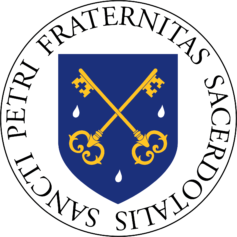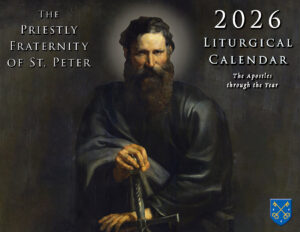Scapular of Our Lady of Ransom
by Rev. Cav. William Rock, FSSP, SMOCSG

September 24th is the feast day of Our Lady of Ransom (Our Lady of Mercy), the titular feast of the Royal, Celestial and Military Order of Our Lady of Mercy and the Redemption of the Captives, more commonly known as the Mercedarians or the Order of Mercy. Originally instituted for the redemption of Christian slaves held by Muslims, “Today, friars of the Order of Mercy continue to rescue others from modern types of captivity,” such as addictions.1
Like other Orders, the Mercedarians have a scapular which can be worn by the faithful in order to associate themselves with the work and spiritual prerogatives of the Order. A ceremony for the blessing and imposition of this white scapular, which can be done by any priest,2 can be found in the traditional Roman Ritual:
The one who is to receive the scapular is kneeling. The priest, vested in surplice and white stole, says:
℣. Our help is in the Name of the Lord.
℟. Who made heaven and earth.℣. Lord, show us Your mercy.
℟. And grant us Your salvation.℣. The Lord be with you.
℟. And with your spirit.Let us pray.
O Lord Jesus Christ, Who condescended to clothe Yourself in our mortal nature, we beg You in Your boundless goodness to bless ✠ this garment, which our holy fathers have sanctioned to be worn in token of innocence and holiness. May he (she), who is to wear it, deserve likewise to put on You, Who live and reign forever and ever.
℟. Amen.The priest sprinkles the habit with holy water, and invests the person with it, saying:
By the power of our Lord Jesus Christ and that of the Apostles Peter and Paul, which has been granted to me, I present you with the habit of the Order of Our Lady of Ransom. This is done in recognition of your devotion to the most holy and immaculate Mary, Mother of God, as well as to the Order founded in her name. And having been so enrolled, may it be your good fortune to have the grace of the Holy Ghost in this life, and everlasting glory, the reward of the elect, in the life to come; in the name of the Father, and of the Son, ✠ and of the Holy Ghost.
℟. Amen.Then the “Veni Creator” is said, followed by:
℣. Send forth Your Spirit and all things shall be recreated.
℟. And You shall renew the face of the earth.℣. Save Your servant.
℟. Who trusts in You, my God.℣. The Lord be with you.
℟. And with your spirit.Let us pray.
O Lord, hear our humble prayers, and be pleased to bless ✠ this servant of Yours whom we clothe in your Holy Name with the habit of the Order of Our Lady of Ransom. He (she) deserves out of piety to wear it as long as he (she) lives, so that by Your bountiful help he (she) may remain loyal to Your Church, and finally attain everlasting life through Christ our Lord.
℣. Amen.3
No doubt there are many Catholics today who are involved in work which would align with that of the Order of Mercy, striving to rescue their fellowmen from captivity, be it due to exploitation, trafficking, addictions, or other similar conditions. It seems to me that it would be fitting for such Catholics to associate themselves more closely with Our Lady of Ransom and the Mercedarians by being clothed in this Scapular. Similarly, those who find themselves subject to one of these modern-day captivities would do well to place themselves under the mantle of Our Lady of Ransom.
Rev. Cav. William Rock, FSSP, SMOCSG was ordained in the fall of 2019 and invested as an Ecclesiastical Knight of the Sacred Military Constantinian Order of St. George in the summer of 2025. He is currently assigned to St. Stanislaus Parish in Nashua, NH.
In support of the causes of Blessed Maria Cristina, Queen, and Servant of God Francesco II, King
- About | Mercedarian Friars USA
- The Old Catholic Encyclopedia, s.v. “Scapular.”
- Rituale Romanum [1957], Titulus IX – Caput 11, 21; English adapted from the Weller translation provided online by EWTN (2, XV, 21)
September 1, 2025









